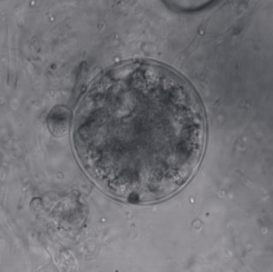Potty mushrooms
| Potty mushrooms | ||||||||||||
|---|---|---|---|---|---|---|---|---|---|---|---|---|

Potty mushrooms ( Chytridiomycota ) |
||||||||||||
| Systematics | ||||||||||||
|
||||||||||||
| Scientific name | ||||||||||||
| Chytridiomycota | ||||||||||||
| ( De Bary ) Sparrow |
The potty mushrooms (Chytridiomycota), also called flagellate mushrooms , form a division of mostly unicellular organisms within the realm of fungi (fungi). The name is derived from the Greek (χυτρίδιον chytrídion = potty), with Chytridium the morphological structure for storing the zoospores that have not yet been released is referred to.
For a while, the potty mushrooms were not considered to be fungi due to the presence of flagellated stages in their life cycle, but today their close relationship with the other groups of fungi is considered very likely. Their tribal sister group is either the yoke mushrooms (Zygomycota) or all other groups of mushrooms. The potty mushrooms may also be paraphyletic with respect to the yoke mushrooms, i.e. certain types of potty mushrooms are more closely related to certain yoke mushrooms than to other potty mushrooms.
construction
The cell walls of the potty mushrooms contain chitin , and sometimes cellulose . Their thallus , the undifferentiated fungal body that is deeply anchored in the host in parasitic species, contains one to many cell nuclei that are not separated from one another by cell walls ( septa ) in the cytoplasm. The only exception to this are the spore-forming structures called sporangia , which are encapsulated from the rest of the thallus by a special cell wall. This prevents the rest of the thallus from leaking out when the spores are emptied from the sporangium. In addition, so-called pseudo-septa occasionally exist, which differ from real septa in the details of their structure and only incompletely separate the cell spaces of the individual nuclei from one another.
metabolism
Potty mushrooms, like many mushrooms, either live as parasites or saprobionts , that is, they live on or even in a host organism from which they obtain their nutrients in a mostly harmful way, or they feed on dead organic material from their environment. To do this, they form long cell threads, the hyphae , which penetrate the victim or the dead matter, release strong decomposing enzymes there and absorb the soluble nutrients via the cell membrane.
distribution and habitat
Potty mushrooms are common in soils, rivers, ponds and lakes around the world. Parasitic species live in their hosts for part of their entire life cycle.
Reproduction
Potty mushrooms can reproduce sexually as well as asexually. During asexual reproduction, special structures called sporangia release innumerable spores that swim around with a back flagellum , germinate upon contact with a host or other food source, and develop into a new, genetically identical individual.
During sexual reproduction, germ cells ( gametes ) are released which, depending on the species, can be identical (isogametes) or different (heterogametes). At least one gamete form is always movable by a back flagellum , a so-called undulipodium, and thus reminds in shape and function of an animal sperm . Some species also achieve fertilization by direct fusion of two hyphae ( somatogamy ).
After fertilization , the zygote usually develops into a resistant spore that can withstand drought, extreme heat and cold. Upon contact with a food reservoir, it germinates into a new fungus that is genetically different from the “parent” organisms.
Interactions with plants and animals
As plant pests, potty mushrooms only play a subordinate role in agriculture and forestry. Olpidium brassicae is for the case of the cabbage family and Synchytrium endobioticum for the so-called potato cancer .
Certain cellulose- digesting potty mushrooms live in the rumen of ruminants and enable them to feed on cellulose- rich foods such as grass. The chytrid fungus ( Batrachochytrium dendrobatidis ), on the other hand, is responsible for the mass deaths of Australian and South American amphibians .
Systematics
In the past, the Neocallimastigaceae were placed with the potty mushrooms. Members of this family do not have mitochondria , they are replaced by so-called hydrogenosomes . Other families formerly assigned to the potty mushrooms such as the Physodermataceae are now grouped together in the new order Blastocladiales .
Currently, a distinction is made between two classes and four orders within the potty mushrooms :
- Class Chytridiomycetes
- Order Chytridiales are all unicellular and have no real hyphae (mycelium). They reproduce sexually through isogametes or somatogamy.
- Order Rhizophydiales
- Order Spizellomycetales
- Class Monoblepharidomycetes
- The order Monoblepharidales is characterized by specialized “male” and “female” germ cells, the androgametes and gynogametes, which are formed in separate structures, the antheridia or oogonia. The androgametes are small and flagellated, the gynogametes relatively large, spherical and immobile.
Individual evidence
- ↑ a b D. S. Hibbett et al .: A higher-level phylogenetic classification of the Fungi . In: Mycological research , May 2007; 111 (5): 509-547. Epub 2007 March 13, 2007, PMID 17572334 .
Web links
- Chytrid Fungi Online (English)